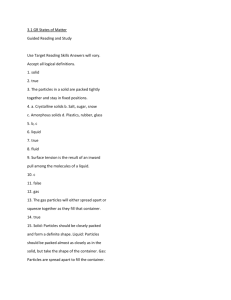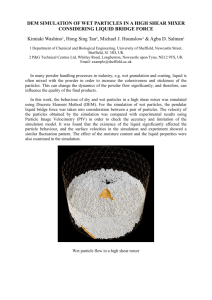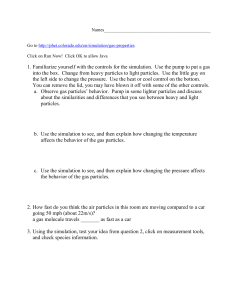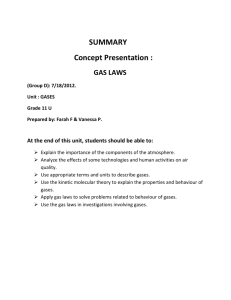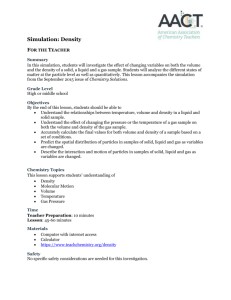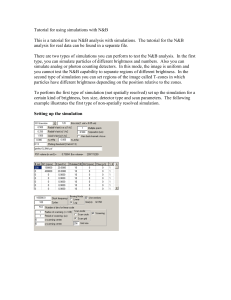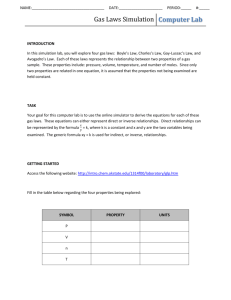Communicating - Bullitt County Public Schools
advertisement
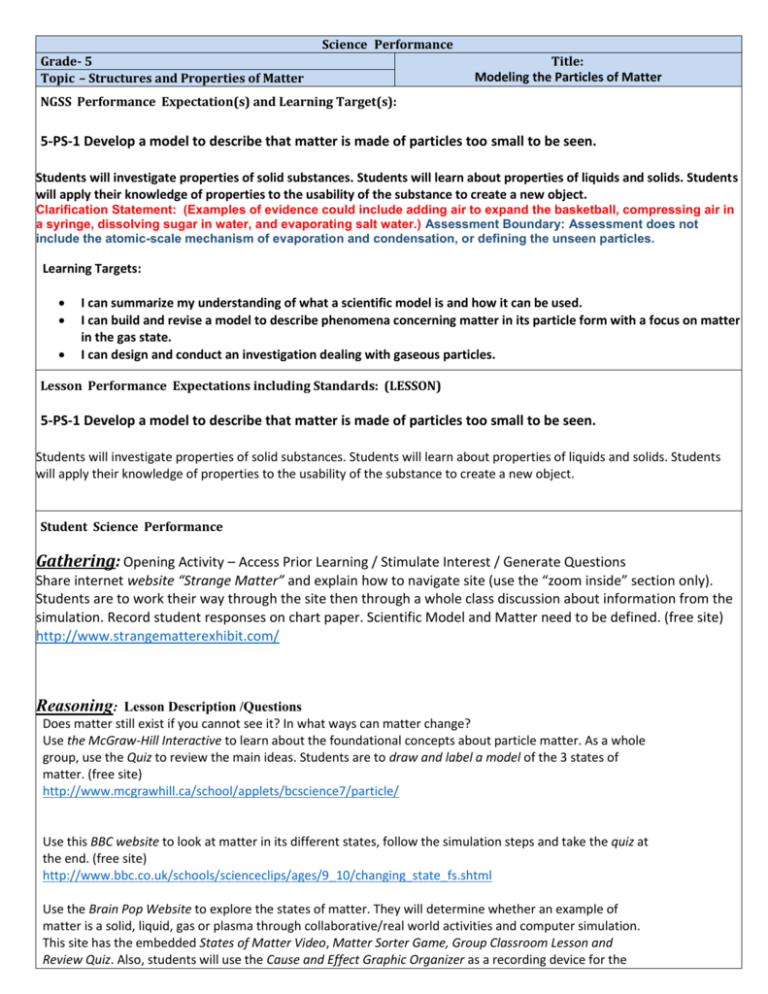
Science Performance Grade- 5 Topic – Structures and Properties of Matter Title: Modeling the Particles of Matter NGSS Performance Expectation(s) and Learning Target(s): 5-PS-1 Develop a model to describe that matter is made of particles too small to be seen. Students will investigate properties of solid substances. Students will learn about properties of liquids and solids. Students will apply their knowledge of properties to the usability of the substance to create a new object. Clarification Statement: (Examples of evidence could include adding air to expand the basketball, compressing air in a syringe, dissolving sugar in water, and evaporating salt water.) Assessment Boundary: Assessment does not include the atomic-scale mechanism of evaporation and condensation, or defining the unseen particles. Learning Targets: I can summarize my understanding of what a scientific model is and how it can be used. I can build and revise a model to describe phenomena concerning matter in its particle form with a focus on matter in the gas state. I can design and conduct an investigation dealing with gaseous particles. Lesson Performance Expectations including Standards: (LESSON) 5-PS-1 Develop a model to describe that matter is made of particles too small to be seen. Students will investigate properties of solid substances. Students will learn about properties of liquids and solids. Students will apply their knowledge of properties to the usability of the substance to create a new object. Student Science Performance Gathering: Opening Activity – Access Prior Learning / Stimulate Interest / Generate Questions Share internet website “Strange Matter” and explain how to navigate site (use the “zoom inside” section only). Students are to work their way through the site then through a whole class discussion about information from the simulation. Record student responses on chart paper. Scientific Model and Matter need to be defined. (free site) http://www.strangematterexhibit.com/ Reasoning: Lesson Description /Questions Does matter still exist if you cannot see it? In what ways can matter change? Use the McGraw-Hill Interactive to learn about the foundational concepts about particle matter. As a whole group, use the Quiz to review the main ideas. Students are to draw and label a model of the 3 states of matter. (free site) http://www.mcgrawhill.ca/school/applets/bcscience7/particle/ Use this BBC website to look at matter in its different states, follow the simulation steps and take the quiz at the end. (free site) http://www.bbc.co.uk/schools/scienceclips/ages/9_10/changing_state_fs.shtml Use the Brain Pop Website to explore the states of matter. They will determine whether an example of matter is a solid, liquid, gas or plasma through collaborative/real world activities and computer simulation. This site has the embedded States of Matter Video, Matter Sorter Game, Group Classroom Lesson and Review Quiz. Also, students will use the Cause and Effect Graphic Organizer as a recording device for the States of Matter (gas state) Experiment. (purchase site) http://www.brainpop.com/educators/community/lesson-plan/matter-sorter-game-lesson-plan/?bptopic=states-of-matter View the Wonderville Clip- Have students record all the representations the filmmakers used for depicting gases. (free site) http://www.wonderville.ca/asset/whattodowithCO2 Communicating: Concepts Explained and Vocabulary Defined Matter is made of particles too small to be seen. Matter of any type can be subdivided into particles that are too small to see, but even then the matter still exists. Pose the question to students- How could you lift this book above the desk? Supply baggies and books-ask student groups to make observations as to what is holding up the book… How could you develop this model (cushion of air) and engineer it into a useable product? Does a balloon gain weight as you fill it? Have students use two methods (blow-up using their lungs and blow-up using a pump) Weigh each method and record to see if there is a difference in the 2 gases. Have students form explanations based on evidence as to why there is a difference. Teacher demonstrates adding air to expand a variety of inflatable objects such as: balloons, basketball, football, beach ball, air mattress, whoopee cushion… Use this site for ideas. https://en.wikipedia.org/wiki/List_of_inflatable_manufactured_goods Student groups will then brainstorm the idea of a model (drawing) that uses a gas to create an object to help people in their everyday life. (Help people learn, swim, live, travel, health, building) Possible rubric: http://www.isbe.net/ils/science/pdf/rubric.pdf Students will use the engineering and design process to create a prototype of the model they drew during the planning stage. Students will share their prototype with the class explaining how it uses gas to help people in everyday life. Use this BBC Website to look at matter in the gas phase, follow the simulation steps and take the quiz at the end. (free site) http://www.bbc.co.uk/schools/scienceclips/ages/9_10/gases.shtml Assessment of Student Learning (Formative and Summative): . Formative Monitoring (Questioning / Discussion): Student Lab Sheets Student built model examples Teacher observations & data records Quick Quizzes Scientific dialogue with students Drawing of model Critical Vocabulary: Vocabulary: Model-Observations-Matter-Particles-States of Matter-Phase Change-Solid-Liquid-Gas Teacher demonstration Screaming Balloons, focus on the effect of gas on a balloon (filling it) http://www.youtube.com/watch?v=aAMW_3kWUhE&safe=active Science Essentials (Student Performance Expectations From Appendix C, D, E) Science Practices Conduct and investigation collaboratively to produce data to serve as a basis Carrying out investigations for creation of a model Creating a model Analyze and interpret data to make sense of phenomena Using mathematical and computational thinking Creating a model Constructing explanations Use evidence to construct or support an explanation Crosscutting Concepts Scale, proportion, and quantity Disciplinary Core Ideas Structures and properties of matter Cause and effect: Mechanism and explanation Matter of any type can be subdivided into particles that are too small to see, but even then the matter still exists and can be detected by other means. A model showing that gases are made from matter particles that are too small to see and are moving freely around in space can explain many observations, including the inflation and shape of a balloon; the effects of air on larger particles or objects. (5-PS1-1) Differentiated groupings Adapted reading materials based on instructional levels(tiered assignments) Prompting, cueing, and paraphrasing as needed Extended time as needed Creation of model(summative assessment) Follow Up Assignment/Project/Work: Presentation of model Modifications and Accommodations for students: (B. Moulding, 2011) Modified/Adapted for Bullitt County Schools by Terry L. Price (2015)






